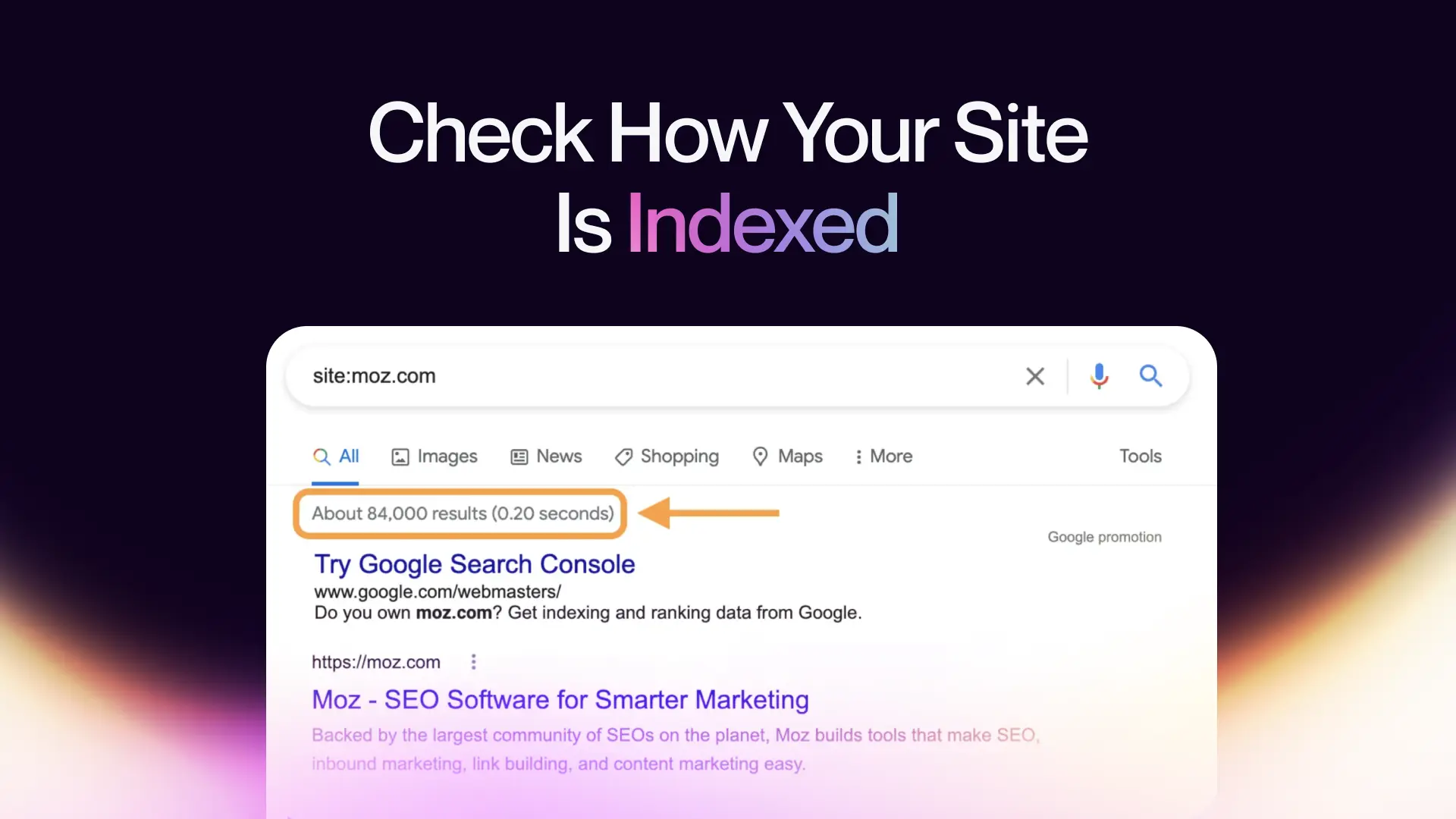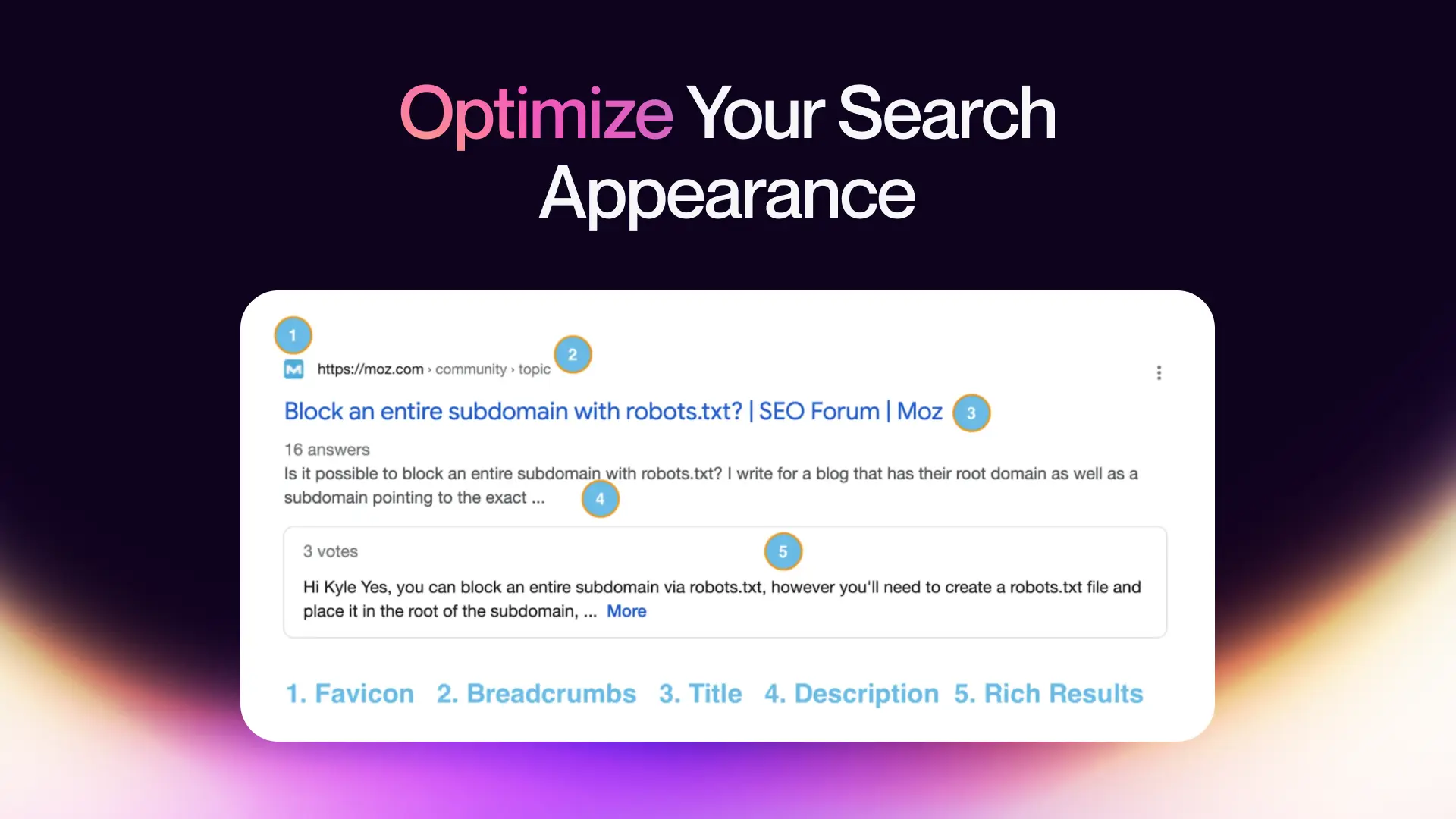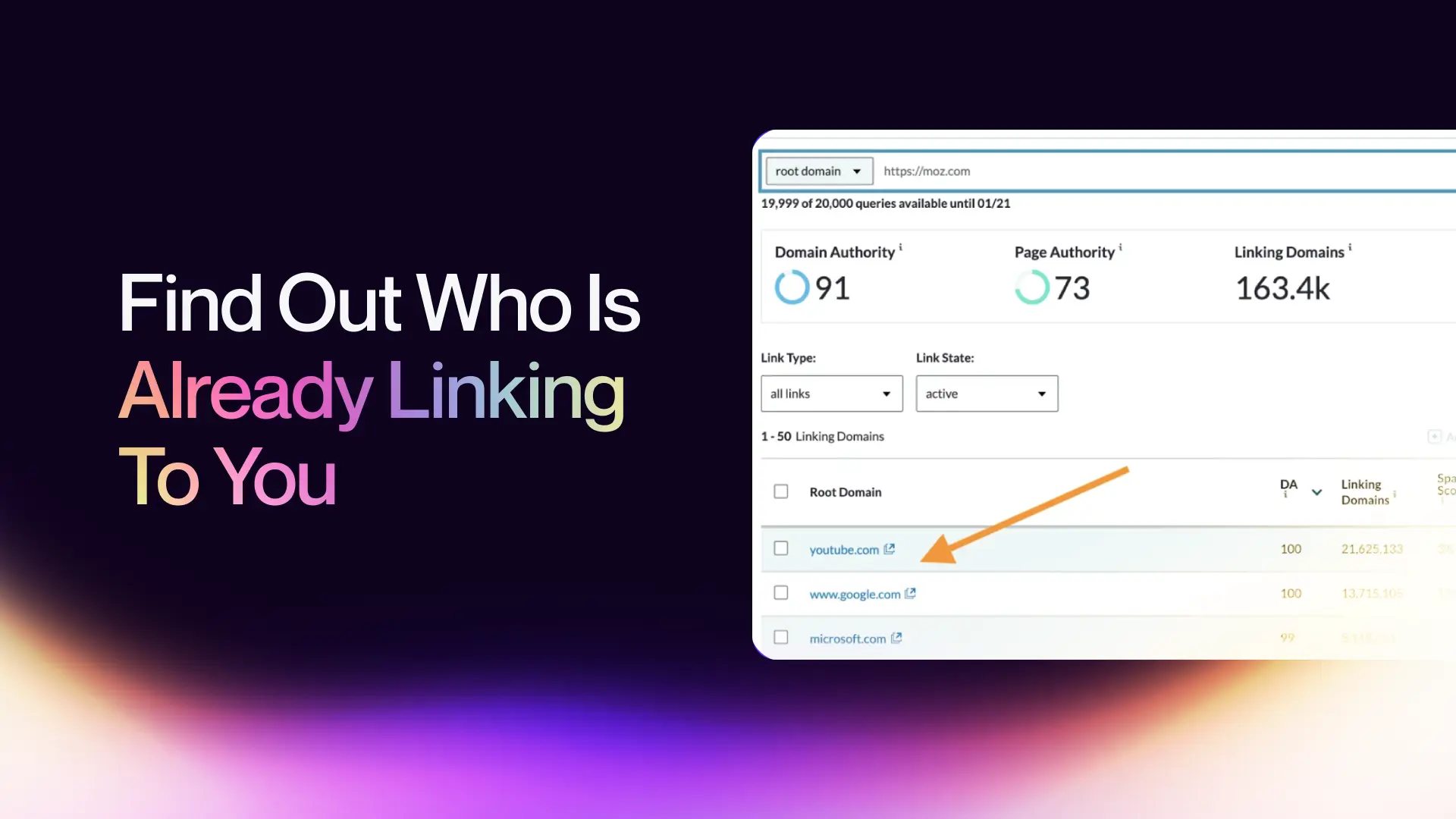Are you ready to jump into the rewarding world of Search Engine Optimization?
You'll benefit from this SEO tutorial if you have a strong desire to learn how to use search engine optimization (SEO) for your website or blog and are willing to carry out the strategies one by one.
This step-by-step SEO guide will cover the basics of SEO, from keyword research and on-page optimization to link-building techniques, making your site friendly to search engines, and more.
Follow each step carefully, and you'll soon be well-versed in organic lead generation!
Ranking On Google Is Essential

Search engine optimization (SEO) is a complex process, so we'll start from the basics.
We’ll discuss topics like keyword research and on-page optimization, as well as link-building techniques that can help improve your website or blog's search engine rankings.
We'll also provide tips to ensure your site is friendly to search engines and explain how to measure the results of your efforts.
You can find
free SEO search engine optimization tutorial resources
online, and many courses are available for those who want to
take the next SEO step.
Whether you’re a beginner or an experienced SEO expert, this SEO step-by-step tutorial guide will help you learn how to use search engine optimization effectively.
With the right knowledge, tools, and techniques, you can make lasting changes that will benefit your website for years.
The SEO Basics Tutorial x
Learn SEO Step by Step
We’ll start our search engine optimization techniques tutorial by outlining the basic steps of SEO. We’ll cover topics like keyword research and on-page optimization, as well as link-building techniques that can help improve your website or blog's search engine rankings.
This is a great starting point for anyone who wants to understand the basic steps of SEO. Here it is:
Snippet/Schema markup
To stand out in SERPs
Title, URL, and description
To draw high CTR in rankings
Great user experience
Including a fast load speed, ease of use, and captivating UI on any device
Keyword optimized
To attract searchers and engines
Compelling content
That provides answers to the searcher's questions
Crawl accessibility
So engines can get to and index your content
From the above, you can see that the foundation of SEO begins with making sure there's crawl accessibility and building on it from there.
With this beginner's SEO guide, you'll take seven steps to successful search engine optimization (SEO).
- Crawl accessibility so search engine spiders can find your content
- Write compelling and share-worthy content that provides answers to questions
- Keyword optimized to attract searchers and engines to your website
- Create a great user experience for visitors on your website with a fast load speed, ease of use, and captivating UX
- Share valuable content that gets links, citations, and amplification.
- Title, URL, and description to receive high CTR in the rankings
- Snippet/schema markup
We'll expand on each of these steps and discuss other topics related to SEO, such as keyword research, on-page optimization, link-building techniques, measuring your results, and more.
Continue reading this SEO guide step by step and have fun.
Chapter 1: SEO 101
What is SEO, and why is it important?
This is for beginners. You'll learn what SEO is and why it's important. You can download the free Quick Start Worksheet.
Chapter 2: How Search Engines Work - Crawling, Indexing, And Ranking
In this chapter, we'll discuss how to make sure that search engine spiders can find all the content on your site and how they rank it. You'll also learn tips for improving crawl accessibility.
Chapter 3: Keyword Research
What is your audience looking for?
In this chapter of the SEO guide for beginner manual, you will find out how to do keyword research and analysis to target the right keywords for SEO success.
We'll also discuss some tools that can help make the process easier.
Chapter 4: On-Page Optimization
Create a winning message from your research.
This broad chapter will teach you the important aspects of on-page optimization, such as user experience, optimized design, information architecture, and more.
You'll learn all the ways you have to tune up your content to get the most out of it in terms of visibility and audience engagement.
Chapter 5: Technical SEO
When you have basic technical SEO ability, you'll be able to optimize your site for search engines and grow your reputation with developers.
When you implement responsive design, robot directives, structured data, and other technical elements like structured data and meta tags, you're taking a big step towards optimizing your website for Google and other search engines.
We'll explain how to implement these strategies in this chapter of the SEO tutorial step-by-step manual.
Chapter 6: Link Building
Increase the sound.
When you have everything ready, you can show your work to the world by building your link profile. We'll discuss how to build quality links naturally and explain why it's one of the important steps to SEO success.
Chapter 7: Measuring, Prioritizing, And Executing SEO
Track progress and measure success.
In this chapter on how to do SEO for a website step-by-step manual, we'll cover how you can use Google Analytics and other tracking tools to measure the success of your SEO efforts.
We'll also discuss how to prioritize tasks and focus on the most important elements for SEO success.
The SEO Glossary
SEO comes with its language. You just have to get used to the industry terms.
That is why search engine optimization tutorials are incomplete without a glossary.
This chapter-by-chapter glossary will help you with the terms related to search engine optimization (SEO). In this step-by-step SEO guide we'll explain the most important concepts and words you need to know to understand SEO, so if there's something you don't understand, be sure to check here first.
Quick Start SEO Guide
Get The Free Worksheet! We've added a Google Sheets worksheet, which you can use to get started with the steps in the SEO process.
It contains everything we've discussed in this guide so far and will help you and your team quickly learn the basics and go along with ease.
Get the free worksheet! We've included a fantastic Google Sheets worksheet to guide you through the steps and help keep you and your team on track.
While SEO is relatively easy, it requires time to master advanced techniques and acquire in-depth knowledge.
With this Bonus SEO Quick Start Guide, you will have the right tools to get started with SEO and build a solid foundation to help your website succeed in the long run. We wish you the best of luck!
When you are new to SEO, you can make informed decisions by following easy SEO steps like those you find in this SEO beginners' tutorial.
These
steps will help you succeed and also act as a foundation for
learning the elementals so that your SEO traffic levels
soar.
For now, let's get started with the basics. By following these simple steps and using the worksheet, you can easily jumpstart your SEO journey. Good luck!
1. Gather Your SEO Data
Doing SEO requires three basic things to begin:
- A website
- Your brain
- Data
You already have a website and a brain. Next is to arm you with the right data.
While the most important data you need will come from your website, there are also many other sources of data.
Keyword research, visitor analytics, and link building are among the most important sources. To succeed, you need to have the following data sources available.
Install Analytics
With web analytics, you get information about the visitors to your website. This will help you identify who visits your site and what content they look for. You can find information about the sources (SEO, Social Media, Referral, or other), their location, the device used, and much more.
Google Analytics is the most popular tool for this. Install it and get started tracking your website now!
Register With Search Engines
Google, Bing, and other search engines reveal free information about your website.
This data can include important metrics like how often your pages appear in the search results, the keywords you rank for, and more. You can get this data by registering with each of these engines and verifying your website.
Here are two of the most well-known search engine analytics services:
- Google Search Console
- Bing Webmaster Tools
While registering your site with search engines may not get you more traffic, it will provide you with the tools you require to get the traffic you desire.
Recommended: Run a Crawl
Although it is not mandatory, we recommend that you run a crawl of your website.
This will provide you with the most in-depth understanding of how search engines look at your site and also help you identify any potential issues that may slow down your SEO efforts.
Duplicate Content Solutions: Whiteboard Friday
Find out how to deal with duplicate content problems with Meghan or look up more Whiteboard Friday episodes.
2. Check How Your Site is Indexed

For your site to turn up in the search results, it needs to be indexed by the search engine. Indexing means a search engine has crawled a page and recorded the content inside it. However, sometimes, a search engine may rank a page it has not indexed. But this is rare.
Perform a Site: Search
You can check if your site is indexed in various ways. The easiest is to perform a site: search. This applies to both Google and Bing. For instance, if you want to check if your home page is indexed, type site:example.com in the search engine and hit Enter. This should tell you how many pages of your website have been indexed.
To check if individual pages are indexed, you can use the same search query, but this time includes other terms. For example, site:example.com/learn/SEO/domain-authority
If Your Site is Not Indexed
If your site isn't indexed, there may be several reasons:
- Is it a new site?
It may take a bit of time for search engines to find, crawl, and index your site. So if it’s a new site, wait for some time before you start worrying about it.
- Does your site provide valuable and unique content?
One of the criteria for a website to be indexed is providing something that can’t be found elsewhere. If your content is not unique and valuable, search engines won't index it.
- Is your site indexed and crawlable?
This involves some technical SEO. There are a few things you can do if you believe that your site should be indexed but isn’t.
You should begin by checking your Site Crawl and/or Google Search Console.
If you have already performed a site crawl using one of the recommended tools in step 1 of this search engine optimization tutorial, it may reveal problems with the site.
Fix these issues and resubmit your site to Google Search Console or any other search engine you want to be indexed by.
You may also enter a URL into Search Console's URL Inspection Tool to check if it is indexed and resolve any indexing issues. If the URL is not available on Google, click the "Test Live URL" button to get a diagnostic report.
Common Technical Indexing Issues
The crawl report and/or Google Search Console should provide you with more information about the issue. Here are some common technical issues:
- The page isn't crawlable and/or doesn't return a 200 status code. Learn more about HTTP Status Codes
- Robots meta directive has prevented indexing. Find out more about robots' meta tags.
- The page is blocked by robots.txt. Learn more about robots.txt.
- The page isn't listed in the sitemap file. While sitemaps are not necessary for crawling and indexing, they help search engines find your content. Learn more about sitemaps.
- Duplicate content problems. If you have the same content in several different locations, search engines may not index your pages. You can resolve this issue with canonicalization or some other methods. Learn more about duplicate content solutions.
Mobile Check: See Your Site Like a Search Engine
This is very important. Even though your site looks cool when you view it on your web browser, how does it look to a search engine? Mobile Check can help you with this.
When you view your site like a search engine, you gain an insight into how search engines see your website. This can help you identify and fix any possible mobile indexing and usability issues.
Now more than ever before, it is important to see how your website looks on mobile devices.
Mobile-first indexing is now a reality, and this means your pages should be optimized for the mobile experience first before anything else. Because most visitors to your website will be using a mobile device, Google uses the mobile version of your site in its ranking.
To see how the mobile version of your site looks to a search engine, simply try out Google's Mobile-Friendly Test.
3. Target Specific Keywords
One amazing aspect of SEO is that your content can be tailor-made to target keywords and phrases that your audience is already searching for. This means that you can bring more high-quality traffic to your website by targeting the right keywords.
To start, identify a few broad industry topics or questions that you want to target with your content. Then you can use keyword research tools such as the Keyword Planner or Ubersuggest to find more specific long-tail keywords related to your topic.
By targeting the right keywords with your content, you can rank higher in search engine results pages for the keywords that are most relevant and valuable to your business.
Keyword research is an invaluable part of SEO. While it takes time to become an expert in it, there are some baby steps you can take to get better at it: That is why you need SEO tutorials for beginners like this one.
Find Out Keywords You Already Rank For

It is good to begin by finding out the keywords and phrases that you already rank for. To get a better idea of the keywords you are already ranking for, enter your domain into Keyword Explorer. This report shows you all of your top-ranking keywords by search volume.
You can also find the keywords you already rank for through the Search Console's Performance Report.
Target Keywords on Your Page
Once you have identified the keywords you want to target, it is time to optimize your page for them. To start, use your targeted keywords in the page title and meta description of your page.
Other places where you can insert keywords are paragraph headers, headlines, and body text. This will help search engines understand what the page is about and rank it for those keywords.
Don't overdo it so much that it starts to look unnatural. Search engines will penalize you for keyword stuffing.
4. Optimize Your Search Appearance

If you turn up in search results, Google takes aspects of your page and displays them in search results.
These elements can influence how many people click on your page from search results. This is called a “search appearance”. It may also affect your ranking as well.
Your search appearance optimization is an essential aspect of SEO. Its main elements are;
- Meta description
- Title tags
- Breadcrumbs
- Rich snippets
- Favicons
As a result of their importance, in this SEO learning step-by-step tutorial, we will deal with each of them separately:
4b. Write Compelling Meta Descriptions
A meta description is a short text snippet that appears below your page titles in search engine results. It should explain to users what they will find when they click on your page and also persuade them to do so.
Write Different, Captivating Meta Descriptions For Each Page
Like titles, meta descriptions should be unique for every page on your website. This helps search engines understand what the page is about and also encourages users to click through to your page. You should target 150-160 characters.
Include Keywords in Your Meta Descriptions
Meta descriptions should also include targeted keywords. This helps search engines understand your page better and boosts its chances of ranking for those terms. It is important to note, however, that keyword stuffing on meta descriptions can be penalized by search engine algorithms.
4c. Get Rich Results With Structured Data
Rich results refer to search results that stand out from the rest. They are usually elements like FAQs, review stars, images, and more.
Using structured data helps to trigger rich results. Modern content management systems like WordPress, Yoast, and Rankmath, for example, have plugins that enable you to add structured data easily. This helps search engines better understand your page content and make it stand out in SERPs.
Use Structured Data on All of Your Pages
Schema types like Article or Product provide basic information to search engines for the majority of your pages, which can trigger rich results. You should use structured data on all of your pages where appropriate.
For this, you can add other schemas. For better results, you should provide more specific information like author, prices, dates, and so on.
Validate Your Structured Data
Once you've added the structured data to your page, it is important to ensure that it is valid. You can use Schema Markup Validator, Rich Results Test, or any other tool to verify the validity of your structured data.
4e. Make Yourself Unique With a Favicon
Favicons are those little icons that appear close to your Google listing on mobile. They can help you stand out from the competition, and make it easier for users to recognize your website when they perform a search.
Define Your Favicon
You should define your favicon in the HTML code of your webpage. You can do this by defining a shortcut icon in the head of your home page that points in the direction of your favicon. Favicons with high contrast and resolution usually show up better in search results.
5. Create Compelling Content
SEO basics tutorials are incomplete without a section on content. Content is the backbone of SEO and there is no better way to improve your search engine rankings than by creating compelling content that resonates with your target audience. Here are some tips for creating SEO-friendly content:
Commence with User Intention in Mind
When creating content, always consider the user’s intention. What are they looking for? Why would they visit your page? Answer these questions before you start writing to ensure that you’re providing the most relevant and valuable content for your audience.
You can start by looking at those things that already rank high for the same keywords as you, and understanding what content they’ve used to achieve their rankings. Remember not to copy them, but use them as a guideline.
Don't Forget Headers And Subheaders
When creating content, always use headers and subheadings (H1, H2, and so on) to structure your article. Headers are important for SEO as it helps the search engine understand what each paragraph is about, which improves on-page SEO.
Make Use of Images
Images can help break up text and make it more visually appealing. They also add context to your content, making it easier for readers to understand what you’re talking about. However, remember to
- Optimize the images before uploading them on your website by adding ALT tags and other relevant information. This helps screen readers and search engines understand your images.
- Don't depend on images for important information. While it's okay to add text to your images, remember that search engines can’t read them like you and us.
- Large images will slow down your website, which will negatively affect your SEO. Always compress images before uploading them to your website.
Visual Search Optimization - Whiteboard Friday
Learn visual search optimization with Crystal or get in on the action with more Whiteboard Friday episodes.
Keep Your Content Interesting and Up-to-Date
Your content needs to be interesting and up-to-date if you want it to rank well in search engines. No one likes reading stale, outdated content so make sure your content is fresh and relevant for the best SEO results. Content refresh can help you improve your out-of-date content.
Optimize For User Satisfaction
User experience is an important factor for SEO, so make sure your website is easy to navigate and use. Your goal should be to ensure that your site is the last click the user makes before they find the answer to their query. Evidence shows that satisfying the user boosts rankings.
6. Internal Links And Site Architecture
Internal linking is an important part of SEO and every SEO lesson because it helps search engines understand your website better. Linking related pages within your site can help visitors quickly access the information they’re looking for and also improve the experience on your website.
Don't Forget to Link All Important Pages
All your important pages should be linked to the homepage and other key web pages. This helps search engines understand what is on your website and which are the most important pages. Orphaned pages with no link from other pages on your site should be avoided. Page visitors should be able to go from your home page to any other page on your website easily with only a few clicks.
Since it may be hard to achieve this on very large websites, consider using XML sitemaps. This will help search engines quickly find all the important pages on your website.
Use Descriptive And Unique Anchor Text
Anchor text is the clickable text on a webpage. When linking to other pages, make sure to use descriptive anchor text that is relevant to the target page. This will help search engines better understand what each page is about and improve rankings for each page.
Remember that anchor texts from external websites should also be descriptive and relevant to the target page. While they are more effective, optimized internal links are also important for SEO. But don't be excessive as over-optimizing your internal links can draw penalties.
Use a Logical URL Structure
Search engines, including Google, use URL structure as one of the ranking signals in its algorithm. You should ensure that your URLs are logical and descriptive. This will help both search engines and users understand what is on each page easier.
For a better SEO result, try to avoid having too many parameters in your URL structure. Keep URLs short for a better user experience.
7. Amplify Your Reach by Building Links
One thing about SEO is that the more popular the site is, the higher it ranks. This is why link building is so important for your SEO efforts. Link building involves getting other websites to talk about your website or include links pointing back to it.
While internal links are necessary, it is external links from other websites that give your SEO efforts a boost. Make sure to create valuable content so that other websites will want to link back to you. You can also use tools such as Buzzsumo to find out what is popular and relevant in the industry and try to get links from those sites.
Find Out Who is Already Linking to You

You should also find out who is already linking to you by using a tool such as Link Explorer. This enables you to know where your website is getting the most links and how you can build upon that existing link-building strategy.
Discover Those Who Link to Your Competitors
You can also use the same tools that reveal who is ranking to you to find out who is linking to your competitors. This will help you identify potential link-building opportunities that you can take advantage of and gain links from websites that have already linked to similar content.
Start by finding out who your competitors are. A tool like Domain Analysis can be used to find out the top websites in any niche. You can then use Ahrefs or other tools to find out who is linking to them and try to get those same sites to link back to you as well.
Don't Get Involved in Link Schemes
It is important to point out that search engines frown upon link schemes. You should avoid buying links, using automated tools for building links, advertising links, or exchanging links with other websites to manipulate rankings. This can get you penalized by Google and other search engines.
Promote Your Site And Your Best Content
Once you have done the work to get your SEO in place, it is important to promote your website and its content. This includes creating social media profiles for your website and sharing your content on them. You can also use email marketing or other methods of digital marketing to reach out to more potential customers.
SEO isn't a one-time effort - it requires ongoing work. You should track your search engine rankings and adjust your strategy as needed. Keep in mind that SEO results don't happen overnight and you will need to be patient while waiting for the rewards of the work that you put in.
By following this SEO tutorial step-by-step, you will be able to start SEO for beginners in no time. Just remember to create valuable content, use the right keywords, and keep track of your progress as you go along. With some effort and dedication, you can see great results in your SEO efforts.
Final Thoughts
SEO is the cornerstone of marketing, it gets you traffic, and garners sales. This quick start guide for beginners can help you achieve real success.





.jpg)